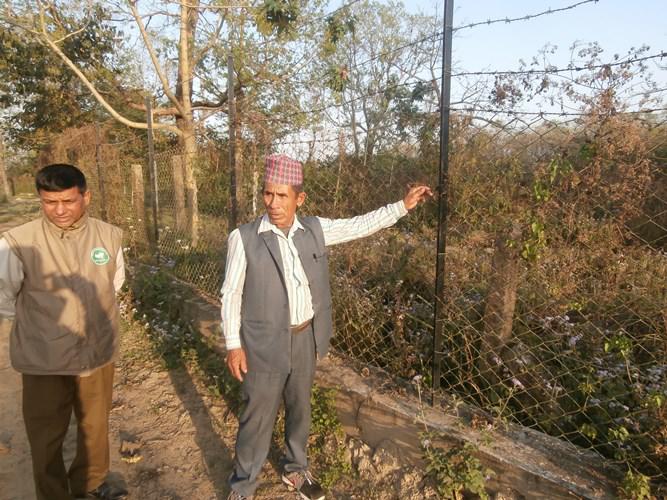Rajendra Dhungana
Other projects
21 Nov 2019
Strengthening Human-Big Cats Conflict Mitigation Efforts in Chitwan National Park, Nepal
This project aims to analyse the spatio-temporal patterns, and socio-ecological, landscape and meteorological correlates of human-leopard conflict, and economic losses and compensation payments made towards such conflict, for the period 2007-2015. Additional component include conservation awareness programmes targeted at local communities and school students.

Chair of a buffer zone user committee briefing about mess cum barbed wire fence constructed in the boundary of Ghailaghari Community forest to prevent leopards entering human settlement.
Leopards are enlisted in vulnerable category in the IUCN Red list of Threatened Species. They are facing a serious threat mainly arising from conflict with humans, poaching, habitat loss, and depletion of wild prey. In Nepal, they are found in a variety of habitats and get involved in livestock and human attacks. This scenario has occasionally led to retaliatory killings of leopards by local people and removal from the wild by authorities. In Chitwan National Park, the leopards are reported to increasingly inhabit in surrounding buffer zone with the restoration of degraded forests occurring since last two decades. They are found in sympatry with tigers and other cats. Leopard's greater adaptability to live in disturbed habitats in the buffer zone might have led to substantial involvement in conflicts.
This project has been designed to analyse human-leopard conflict in the vicinity of Chitwan National Park, Nepal. Chitwan National Park is the first protected area of the country and lies in southern part of Central Nepal along Nepal-India border. The park has been inscribed in World Heritage Site and harbours significant populations of several globally endangered species including tiger, one horned rhinoceros, and gharial crocodile.
The project will examine
(i) spatio-temporal patterns of conflict
(ii) socio-ecological, landscape and meteorological correlates of conflict
(iii) economic losses and compensation payments made towards such conflicts; for the period 2007-2015.
In addition, awareness programs will also be conducted targeting local communities and school students. The data will be mainly collected from office records of Chitwan National Park, questionnaire surveys and key informant interviews, and site observations and verifications. The programs such as ArcGIS 10, R 3.2.3, and Distance 6.0 will be mainly used for data analysis. Major expected outcomes of the project include conflict mapping, exploration of conflict trends, modelling of conflict-correlates, assessment of economic losses and compensation payments, and raised awareness level. The project could contribute in formulating conflict management plans, launching management interventions, and revising compensation scheme.